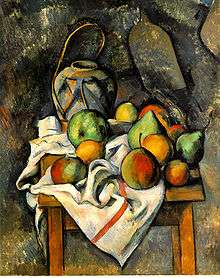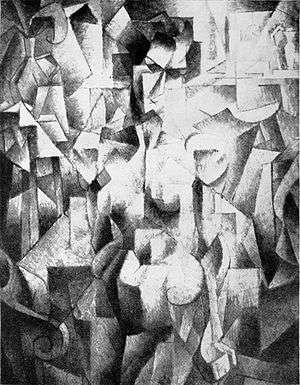Fruit and a Jug on a Table
 | |
| Artist | Jean Metzinger |
|---|---|
| Year | 1916 |
| Medium | Oil on canvas |
| Dimensions | 115.9 cm × 81 cm ( 45 5⁄8 in × 31 7⁄8 in) |
| Location | Museum of Fine Arts, Boston |
Fruit and a Jug on a Table (also titled Melon et compotier) is a Cubist painting created in 1916 by the French artist and theorist Jean Metzinger. In 1919 the painting was exhibited in Paris at Léonce Rosenberg's, Galerie de l'Effort Moderne. The painting was reproduced in the June 1924 (n. 6) issue of Bulletin de l'Effort Moderne.[1] The work is on view at Charlotte F. and Irving W. Rabb Gallery (Europe, 1900–1960, Modernism), Museum of Fine Arts, Boston.[2]
Description
Fruit and a Jug on a Table is an oil and sand on canvas, signed JMetzinger, lower left, and inscribed on the reverse; Peint par moi / en 1916 / Metzinger.[3] The work represents a divers grouping of objects—a bowl of fruit, a carafe (or jug), a glass, and a bottle labelled BANYU. Banyuls-sur-Mer is a commune in the Pyrénées-Orientales department in southern France, located near Cerbère and Collioure. The foothills of Pyrenees run into the Mediterranean Sea in Banyuls-sur-Mer, creating a steep cliff line. Banyuls-sur-Mer is known for its wines, such as the sweet wine Banyuls: a fortified apéritif or dessert wine made from old vines cultivated in terraces on the slopes of the French and Catalan Pyrenees.
The arrangement of objects on the table separated from the background, the moderation of colors, and the curvilinear structuring contrasts from the highly chromatic and sharp angular modeling of Metzinger's 1916 works, suggesting this work may have been completed in 1917.[3]
History
Following World War I Metzinger moved increasingly toward a classical treatment of subjects—as Picasso and several other Cubists—in response to both a growing interest in the classicism and pressures of post-war conservatism; a phenomenon that would encompass a wide range of sectors including music, philosophy, literature and the fine-arts.[4]


Fruit and a Jug on a Table has many characteristic features one would expect to find in Metzinger's work between 1916 and 1919. This painting shows Metzinger on the verge of adopting a more naturalistic stance. Space is increasingly recessive, surface fracturing is more subdued. Though the geometry remains non-Euclidean and perspective in the tradition of Paul Cézanne—as observed in the angle of the table in relation to the objects placed upon it—mobile perspective is almost entirely vacated. Decorative patterns are more restrained, yet surface textures and a thick application of paint enlivening the flat color areas persist as an essential feature of Metzinger's oeuvre.[4]
Considered Cubist in critical circles, the work no longer possess the abrupt angular faceting of Metzinger's pre-1916 Cubism. Colors are consistently anti-natural; forms are rounded, clearly delineated by omnidirectional light and shadow. The geometric armature is reduced to elemental building blocks. Perspective is tightly packed and limited to a depth of field equivalent to a raised relief, as if carved out of stone. Brushwork is dynamic and expressive. The composition is constructed in a vertical format, focusing on the interconnectedness and relationships between divers parts.[4]
Provenance
In April 1919, the painting was with Léonce Rosenberg, Galerie de l'Effort Moderne, Paris.[5] A fragmentary label on the reverse, dated April 1919, bears the name of Léonce Rosenberg and the Galerie de l'Effort Moderne, which Rosenberg founded in 1918. A collector of contemporary French art, Rosenberg had signed a contract with Metzinger in 1916. In exchange for a regular income, the dealer was granted the exclusive rights to Metzinger's artistic production. Metzinger had a solo exhibit at Rosenberg's gallery January 1919. Jean Metzinger's show was followed by exhibitions by Fernand Léger (February), Georges Braque (March), Juan Gris (April), Gino Severini (May), Pablo Picasso (June), Henri Hayden (December 1919), Jacques Lipchitz (January – February 1920), along with several group shows in which Metzinger participated, such as Les Maitres du Cubisme 3 May – 30 October 1920; an exhibit by the same name May 1921; Du cubisme à une renaissance plastique, 1922, and another solo exhibition 16 April – 10 May 1928.[2]
In 1955, Fruit and a Jug on a Table appeared in a public auction, in Paris, sold by an unknown dealer to Marlborough Fine Art, Ltd., London. In 1957, the painting was sold by Marlborough Fine Art to the Museum of Fine Arts, Boston, for £1,200 (accession date: January 10, 1957). This information comes from a letter from Marlborough Fine Art to W. G. Constable of the MFA (January 22, 1957), in the MFA curatorial file.[2]
Published 1920
Fruit and a Jug on a Table was reproduced in Paul Erich Küppers, Der Kubismus; ein künstlerisches Formproblem unserer Zeit, 1920. The painting was titled Stilleben and dated 1917.[6][7]
Notes and references
- ↑ Jean Metzinger, Melon et compotier, 1919, Bulletin de l'Effort Moderne, June 1924 (n. 6)
- 1 2 3 Museum of Fine Arts, Boston
- 1 2 Joann Moser, Jean Metzinger in Retrospect, with Daniel Robbins, The University of Iowa Museum of Art, J. Paul Getty Trust, University of Washington Press, 1985
- 1 2 3 Alex Mittelmann, 2012, Jean Metzinger, Divisionism, Cubism, Neoclassicism and Post Cubism
- ↑ Collection de Léonce Rosenberg, marchand d'art, Jean Metzinger, Nature morte, Ministère de la Culture (France) – Médiathèque de l'architecture et du patrimoine
- ↑ Der Kubismus; ein künstlerisches Formproblem unserer Zeit, 1920. Read online
- ↑ Der Kubismus; ein künstlerisches Formproblem unserer Zeit, 1920, by Klinkhardt & Biermann in Leipzig. Written in German.
External links
- Culture.gouv.fr, le site du Ministère de la culture - base Mémoire
- Culture.gouv.fr, Base Mémoire, La Médiathèque de l'architecture et du patrimoine, works 1–50 of 144
- Agence Photographique de la Réunion des musées nationaux et du Grand Palais des Champs-Elysées

